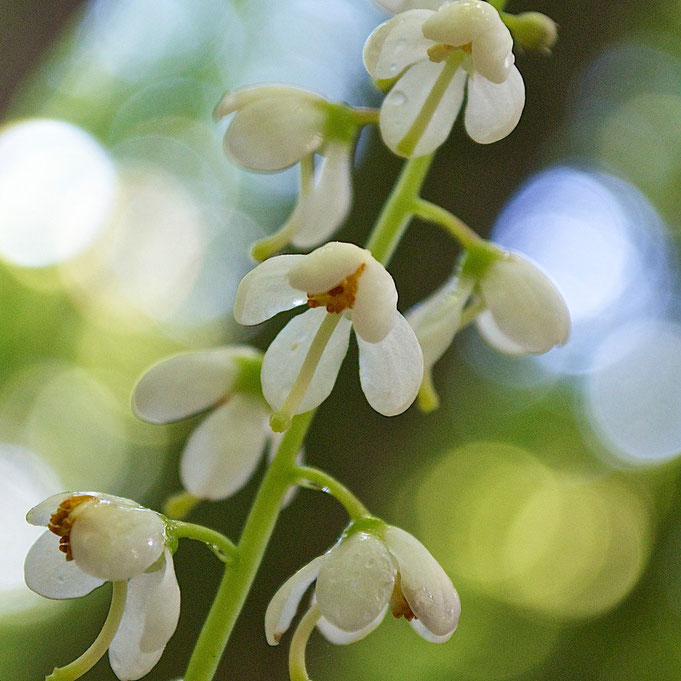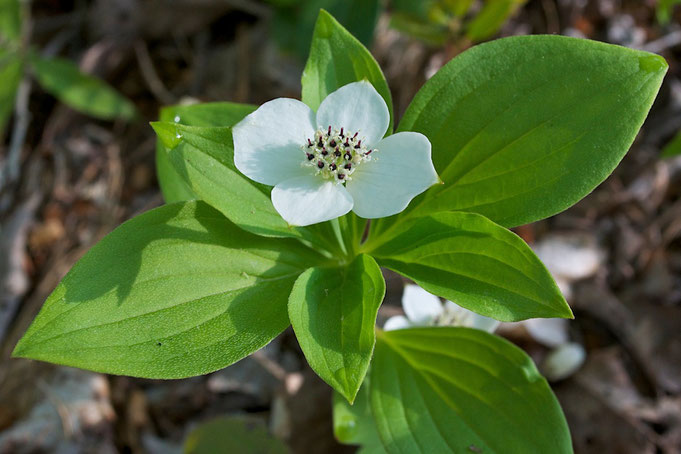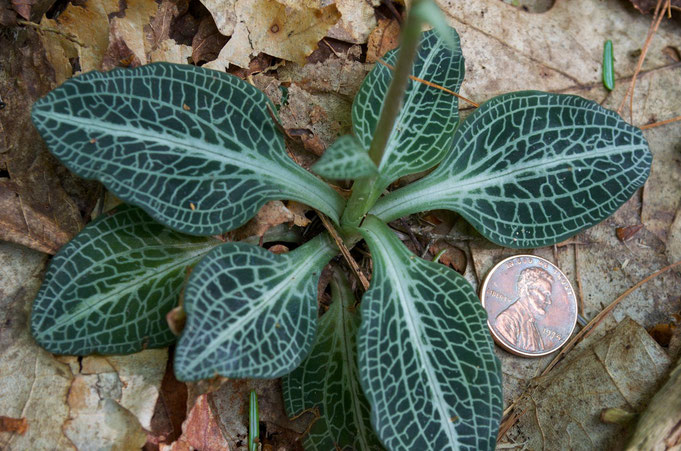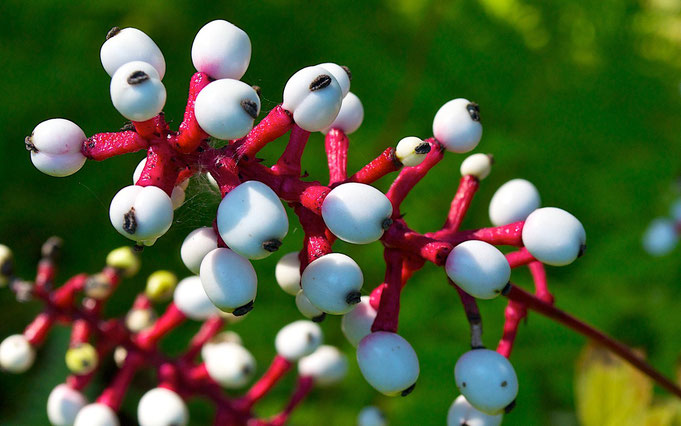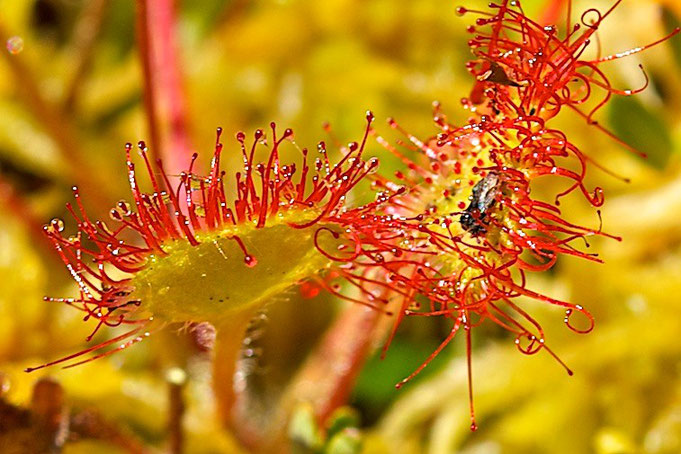native plant
native plant · October 17, 2014
Salidago, commonly called Goldenrod, is a genus of over 100 species of flowering perennial plants in the aster family. The majority are native to North America, with just a few species native to South America and Eurasia. The pollen of Goldenrod is often unfairly blamed for causing hay fever in humans. However, the true culprit is the wind-dispersed pollen of Ragweed (Ambrosia sp.), which blooms at the same time as goldenrod. Goldenrod pollen is too heavy to be easily blown about, with the...
native plant · July 10, 2014
Shinleaf (Pyrola elliptica) is a native perennial wildflower that can be found growing in the woods of Distant Hill Gardens. It is an evergreen herb, 5-10 inches high with a slender, branching rootstock that produces a set of basal, dark green, ovate to elliptical leaves. The naked flower stalk bears from 7-15 white, waxy, drooping, greenish-white flowers, which smell like lily-of-the-valley and bloom in early summer here in southern New Hampshire. Shinleaf is also known as Waxflower Shinleaf...
native plant · June 07, 2014
Canadian Bunchberry (Cornus canadensis) is a woodland perennial flowering in late spring at Distant Hill Gardens. It only reaches a height of about 8 in (20 cm), unlike other taller native dogwoods that are shrubs or small trees. It grows in moist partial shade, often under conifers, and in wooded swamps, shaded bogs and peaty areas. It likes acidic soils, which we don't have much of on Distant Hill. Just a few Bunchberries grow on the acidic shore of the Cranberry Bog/fen under some native...
native plant · February 03, 2014
American spikenard (Aralia racemosa) is one of my favorite shade-loving native plants under cultivation at Distant Hill Gardens. American spikenard is a relative of ginseng. A perennial here at Distant Hill Gardens, it reaches up to 6 feet in height and makes a striking display in the garden. The plant produces tiny greenish-white flowers in rounded clusters in the summer and dark purple-red berries in the fall. One of its most beautiful attributes of Aralia racemosa are its heart-shaped leaves...
native plant · January 16, 2014
Western Pearly Everlasting (Anaphalis margaritacea), also known as simply Pearly Everlasting, is a perennial wildflower that was often used medicinally by North American Indian tribes to treat a range of ailments. Common uses for this species included poultices for treatment of sores, boiling in tea or a steam bath for rheumatism, or smoked to treat colds. The plant was also among many native species of plant used as a tobacco substitute.
native plant · December 16, 2013
Downy rattlesnake-plantain (Goodyera pubescens) is one of three species of the genus Goodyera native to Distant Hill Gardens. It is the most common species of rattlesnake-plantain in New England, and can be easily identified by the broad central stripe down the middle of each leaf. The evergreen foliage is attractive year round, with individual leaves lasting 3 to 4 years. It flowers in late summer with small white flowers densely packed on a slender cylindrical spike, 6 to 18 inches tall....
native plant · November 17, 2012
American Pokeweed (Phytolacca americana) is a perennial herb that is native to much of North America and grows in the woods at Distant Hill. It is a beautiful and very vigorous plant that can grow to a height of more than ten feet. Some research has shown that a protein contained in pokeweed, called pokeweed antiviral protein (PAP), has anti-tumor effects in mice and laboratory studies. It has also been shown to help control some viruses such as herpes and human immunodeficiency virus (HIV)....
native plant · September 15, 2012
All parts of the White Baneberry (Actaea pachypoda) plant are considered poisonous to humans. But, according to Wikipedia, both Native Americans and settlers made tea out of the roots for relieving pain of childbirth. The early colonists also used the plant to improve circulation and to cure headache or eyestrain. This plant is sometimes called Dolls Eyes because the white fruits resemble the china eyes once used in dolls.
native plant · September 14, 2012
This Jack-in-the-Pulpit (Arisaema triphyllum) was transplanted from our woods here at Distant Hill Gardens, and is doing extremely well in a shade garden on the path to the swimming pond. This plant is a herbacious perennial that grows from a corm, and is native to eastern North America.
native plant · July 31, 2012
Extracts of the Round-leaved Sundew, also called Common Sundew (Drosera rotundifloia) have show great efficacy as an anti-inflammatory and anti-spasmodic. The sundew was used during the middle ages to treat the plague, and is used today as a Homeopathic cough remedy. There are hundreds of Round-leaved Sundew growing in the bog at Distant Hill Gardens. Sundews comprise one of the largest genera of carnivorous plants, with near 200 known species. The plant feeds on insects, which are attracted to...
Distant Hill was listed as one of the Top 10 Places to Visit in New Hampshire!
Friends of Distant Hill (dba Distant Hill Gardens and Nature Trail) is a nonprofit,
tax-exempt organization under Section 501(c)(3) of the U.S. Internal Revenue Code.
Donations are tax-deductible as allowed by law. Tax ID# 84-3765898
or send a check via Snail Mail to:
Distant Hill Gardens and Nature Trail, 507 March Hill Road, Walpole, NH 03608


